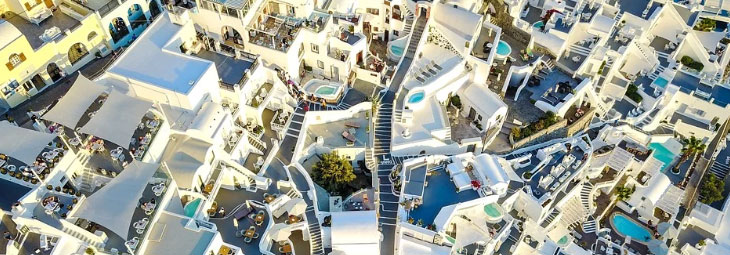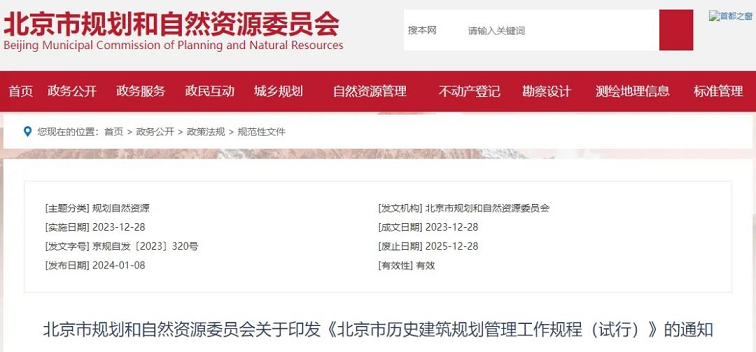


From 2019 to 2021, Beijing announced the authentication of 1056 historical buildings in three rounds. Spanning a period of 700 years and encompassing all 11 districts of the city, these historical structures exhibit diverse architectural styles and serve various functions, constituting a crucial component of Beijing's rich cultural heritage.
To implement the "Beijing Regulations on the Protection of Historical and Cultural Cities" and further refine the policy framework for the protection and revitalisation of historical buildings in Beijing, extensive research was organized by the Municipal Planning and Natural Resources Commission for soliciting opinions from relevant entities and experts. Drawing on the experiences of pilot projects, four focus of ‘Saving the structure of heritage’, ‘Using the function of heritage’, ‘Managing the needs of heritage’, ‘Lightening the future of heritage’ was established and followed with practical guidance.

Consist of eight chapters and twenty-six articles, the regulation differentiates the degree of intervention during the protection and utilization process, thus categorized the actions involved in revitalisation into five types. The Regulations explicitly outline the protection requirements and approval processes for each category of measures, serving as guidance for those responsible for protection and the relevant administrative authorities. This effort is undertaken in conjunction with the optimization of the business environment, urban renewal policies, and other initiatives, thereby refining the implementation pathway for the planning and management of historical buildings in Beijing.
Clarifies the boundary of protective actions
To Save the structure of heritage
For prioritizing the effective protection of heritages, the regulation categorizes the actions regarding heritage reconstruction into five types based on the varying degrees of intervention, including "Routine Upkeep"; "Maintenance and Repairs"; "In-situ Reconstruction"; "Relocation"; and "Demolition". By defining the boundaries of each type of protective action, the Regulation aims to avoid "constructive destruction" caused by any ambiguous delineations. Additionally, compared to ordinary engineering projects, the protection of historical buildings is required to be more defined and delicate, employing meticulous efforts tailored to different situations and specifying baseline requirements for each type of protective action.
The "Regulations" delineate the work content and requirements for the planning and approval of historical building protection and reconstruction. These include a series of activities such as surveying, safety assessment, value evaluation, restoration measures, impact analysis, scheme formulation, expert validation, and archival preservation. By adhering to the stipulations at each stage, the Regulations ensure the proper protection of the value of historical buildings.
Dynamically combines protection and revitalisation
Reuse the function of heritage
The "Regulations" adhere to the principle of simultaneous development and protection, emphasizing the distinction between the conservation and renovation aspects based on the characteristics of historical buildings. This approach avoids a one-size-fits-all strategy and effectively promotes the revitalization of historical buildings. In cases involving in-situ maintenance and restoration, efforts should be made to maximize the preservation of authenticity. Valuable components should be repaired or reconstructed according to the original materials, craftsmanship, and forms. For sites requiring updates due to reasonable utilization needs, adaptive measures such as partitioning, connecting, or transforming internal or external spaces can be employed to meet functioning requirements moderately. The use of new materials, technologies, and modern design approaches is permissible, but it should be coordinated with the historical context and, wherever possible, be discreetly integrated so that it could fuse into the original architectural texture. Simultaneously, the "Regulations" explicitly define control requirements for adding necessary facilities and equipment to ensure that the updating process does not compromise the core values of historical buildings and remains in harmony with their historical architectural aesthetics.
Standardizes the planning approval process
To Manage the needs of heritage
The Regulations strictly corresponds to the requirements of the Ordinance, connecting with the standardized management requirements for administrative licensing, inspection, supervision, and punitive measures in Beijing. It systematically clarifies the implementation pathways for the five types of actions, improving the overall planning management procedures. This assists individuals responsible for protection in determining which actions can be undertaken independently, which require approval, and what materials need to be submitted for review. During maintenance and repairs, if the protective design scheme does not alter the building's use, scale, external outline, courtyard layout, or main structural components, simplified approval measures can be introduced to enhance the project efficiency.
For special historical buildings which illegible for maintenance and repairs or at risk of damaging, the Regulations impose strict control requirements. It standardizes the declaration conditions, argumentation process, and approval process for reconstruction at the original site, relocation, and demolition, ensuring effective protection of historical buildings. The "Regulations" emphasize cautious decision-making, organizing experts to review the necessity, authenticity, and coordination through the "multiple regulations in one" platform. They also involve relevant supervisory departments in joint approval and, when necessary, report to the municipal government for a decision.
Furthermore, the Regulations specify the requirements for the preparation of protection design schemes, addressing questions for individuals responsible for protection regarding "how to prepare" and providing a basis for authorities in determining "what to review" during scheme approval.
Elucidate and exhibit the cultural value
Revitalise the future of heritage
The Regulations embody the philosophy of promoting conservation through utilization, requiring an objective understanding of the values of historical imprints from different periods. It encourages optimizing functional use to meet modern needs and promoting the inheritance of cultural conservation, all while retaining the core values of historical buildings. Subject to planning and conservation requirements, and in accordance with relevant regulations on business environment reform and urban renewal in the city, internal renovations, external expansions, or adjustments in usage can be carried out for historical buildings. The aim is to enhance the building’s performance and meet reasonable usage needs, enabling historical buildings to be sustainably utilized as physical exhibits of cultural heritage, thereby serving as a robust practical implementation of the capital city’s contemporary cultural heritage conservation principles.
Furthermore, Beijing has issued the "Regulations on the Recognition and Registration of Protected Objects in Beijing's Historical and Cultural Cities (Trial)," which explicitly outlines the classification criteria for historical buildings. It delineates the responsibilities and requirements of government departments at all levels in the declaration, registration, pre-protection, and publication stages of historical buildings. Additionally, the publication of the public education booklet "Understanding Historical Buildings Around Us" aims to disseminate relevant knowledge to the citizens and raise public awareness for the protection of historical buildings.
Source:<https://mp.weixin.qq.com/s/gRONzRxMFjTsNYxFJRORqA>
Translated by Xiong Yuxi